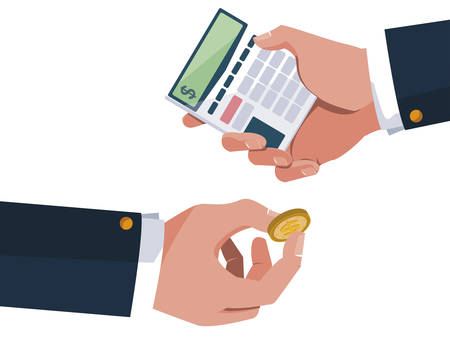1. Understanding Bitcoin and Its Importance
Bitcoin is a decentralized digital currency that allows people to send and receive payments without the need for a central authority like a bank or government. It was created in 2009 by an anonymous person or group using the name Satoshi Nakamoto. Since then, Bitcoin has gained global recognition and is now considered a valuable asset in the financial world.
How Bitcoin Works
Bitcoin operates on a technology called blockchain, which is a distributed ledger that records all transactions across a network of computers. This ensures transparency and security while preventing fraud and manipulation. Here’s how Bitcoin transactions work:
(1) Decentralization
Unlike traditional currencies, Bitcoin is not controlled by any central bank or government. Instead, it runs on a peer-to-peer network where users can transact directly with each other.
(2) Blockchain Technology
The blockchain acts as a public ledger that records every Bitcoin transaction. Each block in the chain contains a set of transactions, and once verified, it is added permanently to the chain.
(3) Mining Process
Bitcoin transactions are verified by miners who use powerful computers to solve complex mathematical problems. In return, they are rewarded with newly minted Bitcoins.
Why Bitcoin Is Valuable
The value of Bitcoin comes from several key factors that make it unique compared to traditional currencies and assets:
| Factor | Description |
|---|---|
| Limited Supply | There will only ever be 21 million Bitcoins in existence, making it scarce like gold. |
| Decentralization | No single entity controls Bitcoin, reducing risks of manipulation or inflation. |
| Security | The blockchain technology behind Bitcoin ensures secure and transparent transactions. |
| Global Accessibility | Anyone with an internet connection can access and use Bitcoin, regardless of location. |
| Pseudonymity | While transactions are recorded on the blockchain, users do not need to reveal their personal identities. |
2. How to Buy Bitcoin Safely
Buying Bitcoin securely is essential to protect your investment from fraud and hacks. Follow this step-by-step guide to purchase Bitcoin safely through reputable exchanges while using secure payment methods.
(1) Choose a Reputable Exchange
Selecting a trustworthy exchange is the first step in buying Bitcoin. Look for platforms with strong security features, regulatory compliance, and positive user reviews.
| Exchange | Security Features | Regulatory Compliance |
|---|---|---|
| Coinbase | Two-factor authentication (2FA), cold storage | Registered with FinCEN, complies with U.S. regulations |
| Kraken | Advanced encryption, 2FA, cold storage | Regulated in multiple jurisdictions, U.S. compliant |
| Binance.US | KYC verification, 2FA, withdrawal whitelisting | Operates under U.S. financial laws |
(2) Create and Secure Your Account
Once youve chosen an exchange, sign up for an account using a strong password and enable two-factor authentication (2FA) to enhance security.
(3) Verify Your Identity (KYC Process)
The majority of regulated exchanges require identity verification to comply with anti-money laundering (AML) laws. Be prepared to submit a government-issued ID and proof of address.
(4) Deposit Funds into Your Exchange Account
You can fund your account using various payment methods. Each option has different fees and processing times.
| Payment Method | Processing Time | Fees | Security Level |
|---|---|---|---|
| Bank Transfer (ACH) | 1-5 business days | Low or free | High |
| Credit/Debit Card | Instant | Higher fees (2-4%) | Medium (risk of chargebacks) |
| P2P Transfers (PayPal, Cash App) | A few minutes to hours | Might include additional service fees | Medium (depends on platform security) |
| Crypo Deposit from Wallets | A few minutes to hours (depending on blockchain congestion) | No exchange fees (network fees apply) | High if using a secure wallet |
(5) Buy Bitcoin on the Exchange
You can purchase Bitcoin in different ways based on your preferences:
- Market Order: Buy instantly at the current market price.
- Limit Order: Set your desired price; the order executes when the market reaches it.
- Dollar-Cost Averaging (DCA): Invest small amounts regularly to reduce market volatility risks.
- P2P Trading: Some exchanges offer peer-to-peer trading options where you can buy directly from other users.
(6) Transfer Bitcoin to a Secure Wallet
Avoid keeping large amounts of Bitcoin on exchanges due to hacking risks. Move your funds to a secure crypto wallet.
| Wallet Type | Description | Main Security Feature | User Accessibility Level |
|---|---|---|---|
| Custodial Wallets (Exchange Wallets) | Your exchange holds the private keys for you. | Password-protected but vulnerable to exchange hacks. | User-friendly but less control over assets. |
| Non-Custodial Wallets (Software Wallets) | You control your private keys. | Password + recovery phrase required for access. | Easier than hardware wallets but still requires security awareness. |
| Hardware Wallets (Cold Storage) | A physical device storing Bitcoin offline. | No internet connection; immune to online hacks. | The safest option but requires careful handling of backup phrases. |
| Paper Wallets (Physical Backup) | Your private key is printed or written down on paper. | No digital exposure; immune to cyber attacks. | Difficult for beginners; risk of loss or damage. |
| Multi-Signature Wallets | Takes multiple approvals before transactions are executed. | Adds extra layers of security by requiring multiple private keys. | Slightly more complex but offers enhanced protection for large holdings. |
(7) Enable Additional Security Measures
- TWO-FACTOR AUTHENTICATION (2FA): Add an extra layer of protection against unauthorized access.
- Password Manager: Use strong and unique passwords for exchange accounts and wallets.
- Withdrawal Whitelisting: Allow withdrawals only to pre-approved wallet addresses.
- Keep Private Keys Offline: Never share your private key and store it securely.
- Beware of Phishing Scams: Avoid clicking suspicious links or downloading unknown files.
- Regular Security Updates: Keep apps, wallets, and devices updated against potential vulnerabilities.
If you follow these steps carefully, you can safely buy and store Bitcoin without unnecessary risks. Next, we will discuss how to sell Bitcoin securely while maximizing returns.

3. How to Sell Bitcoin Securely
Selling Bitcoin can be straightforward, but ensuring security and efficiency is crucial. Choosing the right platform, understanding fees, and taking precautions against fraud can help you maximize profits while minimizing risks.
Choosing the Right Platform
When selling Bitcoin, selecting a reliable platform is essential. Here are some common options:
| Platform Type | Pros | Cons |
|---|---|---|
| Cryptocurrency Exchanges (e.g., Coinbase, Binance) | – High liquidity – Competitive rates – Multiple withdrawal options |
– Transaction fees – Requires identity verification |
| P2P Marketplaces (e.g., Paxful, LocalBitcoins) | – Direct transactions with buyers – More payment methods available – Can negotiate prices |
– Risk of scams – May take longer to find buyers |
| Bitcoin ATMs | – Instant cash conversion – No need for bank accounts |
– High fees – Limited availability in some areas |
| Brokers & OTC Desks | – Best for large transactions – Personalized service |
– Higher minimum trade amounts – May have extra fees |
(1) Tips for Selling Bitcoin Efficiently
- Select the best time to sell: Monitor market trends and sell when prices are high.
- Avoid unnecessary fees: Compare transaction fees on different platforms before selling.
- Diversify your selling methods: Use multiple platforms to get the best rates and avoid liquidity issues.
- Be mindful of tax implications: Keep records of your transactions to report gains or losses properly.
(2) Minimizing Risks During Transactions
(1) Use Reputable Platforms Only
Avoid unknown or unregulated exchanges that may have security vulnerabilities or fraudulent activities.
(2) Enable Two-Factor Authentication (2FA)
Add an extra layer of security by enabling 2FA on your exchange account to prevent unauthorized access.
(3) Verify Buyer Reputation in P2P Transactions
If selling on a P2P marketplace, check the buyer’s feedback and transaction history before proceeding.
(4) Use Escrow Services When Necessary
P2P platforms often provide escrow services that hold the funds until both parties confirm the transaction.
(5) Avoid Public Wi-Fi When Selling Online
Sensitive financial transactions should always be done on a secure network to prevent hacking risks.
(6) Be Aware of Scams and Phishing Attempts
Nobody should ask for your private keys or personal details. Always verify website URLs before logging in.
4. Best Practices for Storing Bitcoin
Once youve bought Bitcoin, the next crucial step is storing it safely. There are several storage options available, each with its own level of security and convenience. Choosing the right one depends on your needs, whether youre holding Bitcoin for the long term or using it for frequent transactions.
Understanding Different Wallet Types
Bitcoin wallets come in various forms, each offering a different balance between security and accessibility. Below is a comparison of the most common types:
| Wallet Type | Description | Security Level | Best For |
|---|---|---|---|
| Hardware Wallets | A physical device that stores private keys offline. | Very High | Long-term investors |
| Software Wallets | A digital application that stores private keys on a computer or mobile device. | Moderate | Daily transactions |
| Paper Wallets | A printed version of your private keys, kept offline. | High (if stored securely) | Cold storage users |
| Custodial Wallets | A wallet provided by an exchange or third party. | Low to Moderate | Beginners, frequent traders |
The Importance of Hardware Wallets
A hardware wallet is one of the safest ways to store Bitcoin because it keeps your private keys offline, reducing the risk of hacking. Popular brands include Ledger and Trezor.
(1) How Hardware Wallets Work
You connect the device to your computer only when making a transaction, ensuring your private key remains secure from online threats.
(2) Setting Up Your Hardware Wallet
– Purchase from an official source to avoid tampered devices.
– Follow the setup instructions carefully and create a secure PIN.
– Write down and store your recovery phrase in a safe place.
The Role of Software Wallets in Daily Use
If you frequently trade or use Bitcoin for payments, a software wallet can be convenient. However, they are more vulnerable to cyber threats than hardware wallets.
(1) Choosing a Secure Software Wallet
– Opt for wallets with strong security features like two-factor authentication (2FA).
– Regularly update your wallet software to patch potential vulnerabilities.
(2) Backup and Recovery Plan
– Always back up your wallets recovery phrase.
– Store backups in multiple secure locations to prevent loss.
Addition of Extra Security Measures
No matter which wallet type you choose, following these best practices will enhance your security:
(1) Enable Two-Factor Authentication (2FA)
This adds an extra layer of protection by requiring a second form of verification when accessing your wallet.
(2) Use Strong Passwords and Encryption
– Create complex passwords that are hard to guess.
– Avoid reusing passwords across different platforms.
(3) Be Wary of Phishing Attacks
– Never share your private keys or seed phrases with anyone.
– Double-check URLs before entering sensitive information.
(4) Consider Cold Storage for Large Holdings
If you hold a significant amount of Bitcoin, using cold storage (offline wallets like hardware or paper wallets) minimizes risks associated with online threats.
Taking the time to implement these security measures ensures that your Bitcoin remains safe from potential threats while giving you peace of mind in managing your digital assets.
5. Avoiding Scams and Staying Safe
As Bitcoin grows in popularity, so do scams targeting investors. Understanding common fraud tactics and knowing how to protect yourself can help you safely navigate the crypto space.
Common Bitcoin Scams
Scammers use various tactics to trick investors. Here are some of the most common Bitcoin scams:
| Scam Type | Description |
|---|---|
| Ponzi Schemes | Fraudulent investment programs that promise high returns but pay old investors with new investors money. |
| Phishing Attacks | Email or website scams designed to steal your login credentials or private keys. |
| Pump-and-Dump Schemes | A group artificially inflates a coin’s price, then sells off their holdings, leaving others with losses. |
| Fake Wallets and Exchanges | Fraudulent platforms that look legitimate but steal your funds once you deposit money. |
| Impersonation Scams | Scammers pretending to be influencers, celebrities, or customer support representatives to trick users into sending Bitcoin. |
Red Flags to Watch For
If an offer sounds too good to be true, it probably is. Watch out for these warning signs:
- (1) Guaranteed Profits: No legitimate investment can guarantee high returns with no risk.
- (2) Urgency and Pressure: Scammers often push you to act quickly to avoid missing out.
- (3) Unverified Platforms: Always research exchanges and wallets before using them.
- (4) Requests for Private Keys: No legitimate entity will ever ask for your private keys.
- (5) Suspicious Links or Emails: Be cautious of emails claiming issues with your account requiring urgent action.
How to Safeguard Your Investments
You can take several steps to protect yourself from fraud and hacking attempts:
(1) Use Reputable Exchanges and Wallets
Select well-known platforms with strong security features and positive user reviews.
(2) Enable Two-Factor Authentication (2FA)
Add an extra layer of security by enabling 2FA on all accounts related to Bitcoin transactions.
(3) Store Bitcoin in a Hardware Wallet
A hardware wallet keeps your private keys offline, making it much harder for hackers to access your funds.
(4) Double-Check URLs and Email Senders
Avoid clicking on suspicious links; always verify website addresses before entering sensitive information.
(5) Stay Informed About the Latest Scams
The crypto landscape is constantly evolving—stay updated on new scam tactics through trusted sources.
(1) Report Suspicious Activity
If you suspect a scam, report it to relevant authorities such as the Federal Trade Commission (FTC) or cryptocurrency exchange support teams.
(2) Educate Yourself Continuously
The more you learn about Bitcoin security, the better equipped youll be to protect your investments.


